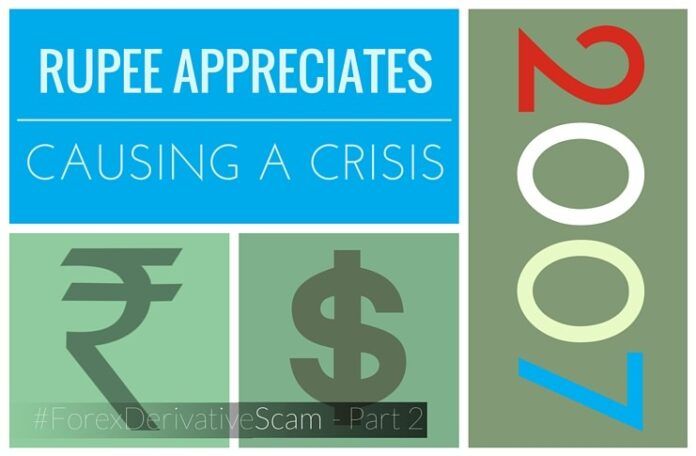
In Part 1 of this series, we described the nuances of currency trading and how they are different from stocks/ options. Industries that do a lot of import/ export need to be able to manage the currency fluctuations and still be able to turn a profit. To be able to weather out the changes, it is not uncommon to hedge one currency.
Hedging in the commodities market: Hedging can be thought of as a way to guarantee the price of a certain commodity regardless of what the retail price is. An example would be that of an airline company wanting to buy oil at a fixed rate for a period of 6 months regardless of what the retail price of crude is. If the price goes up, the airline wins because it is guaranteed delivery at a set price and if the price goes down, the airline loses since it cannot take advantage of a lower price. But any company needs to have the certainty of an essential ingredient to plan its operations so this works out well in the long run. The same applies to currency fluctuations for companies who are dependent on a stable exchange rate for their operations.
What is a Derivative?
A foreign exchange derivative is a financial derivative whose payoff depends on the foreign exchange rate(s) of two (or more) currencies. These instruments are commonly used for currency speculation and arbitrage or for hedging foreign exchange risk. Arbitrage is the simultaneous purchase and sale of an asset to profit from a difference in the price. It is typically done to take advantage of market inefficiencies.
A Simple Arbitrage Example
As a simple example of arbitrage, consider the following. The stock of Company X is trading at $20 on the New York Stock Exchange (NYSE) while, at the same moment, it is trading for $20.05 on the London Stock Exchange (LSE). A trader can buy the stock on the NYSE and immediately sell the same shares on the LSE, earning a profit of 5 cents per share. The trader could continue to exploit this arbitrage until the specialists on the NYSE run out of inventory of Company X’s stock, or until the specialists on the NYSE or LSE adjust their prices to wipe out the opportunity.
More on Derivatives
Derivatives are financial contracts designed to create pure price exposure to an underlying commodity, asset, rate, index or event. In general they do not involve the exchange or transfer of principal or title. Rather their purpose is to capture, in the form of price changes, some underlying price change or event. The term derivative refers to how the price of these contracts is derived from the price of some underlying security or commodity or from some index, interest rate or exchange rate. Examples of derivatives include futures, forwards, options and swaps, and these can be combined with each other or traditional securities and loans in order to create hybrid instruments.
Derivatives play an important and useful role in hedging and managing risk, but they also pose several dangers to the stability of financial markets and the overall economy.
A rapidly appreciating Rupee
We are just defining a few essential terms to understand what is going to follow in this series. It is not our intent to bamboozle you with fancy jargon – rather it is an attempt to simplify it. What transpired in the years 2007-08 to the Small and Medium Enterprises (SME) when they were faced with a rapidly appreciating Rupee? Let us take a trip down memory lane…
During the first half of 2007, Indian exporters were in the midst of an unprecedented situation on account of a sudden and steep appreciation of Rupee against US Dollar. It may be noted that this was unprecedented simply because Indian Exporters had been historically accustomed to a depreciating Rupee vis-a-vis the Dollar. Therefore, when the tables were turned and the Rupee began appreciating, that too without any signal from the Reserve Bank of India (RBI), exporters were confronted with an unfamiliar situation without any effective tool whatsoever to manage it. In early 2007, the Rupee traded at around 45 to a dollar and in a matter of months, the exchange rate changed to around 40 to a dollar! The SMEs were competing in a global market – they couldn’t afford to raise their prices nor could they lower the salaries of their employees. Think of being between a rock and a hard place!
What caused the appreciation? According to The Economist, it was a flood of Foreign exchange inflows, especially US dollars. It was also a period when the effect of Participatory Notes was significant in Indian markets. It was as if the world discovered that there was an easy way to make money in India, without paying any capital gains taxes and do this over and over (also called round-tripping).
In this series, we will detail how this vulnerability of the SME may have been exploited. #ForexDerivativeScam series of posts will detail how SMEs across the country were sold Exotic Derivatives (more on this in our next post) to supposedly ride out the Forex crisis they were facing.
- Subramanian Swamy approaches Supreme Court on Govt’s modification of 2G Scam Judgment to avoid auction of Satellite Spectrum - April 23, 2024
- Defence Minister Rajnath Singh visits Siachen. Reviews military preparedness - April 22, 2024
- Amit Shah’s shares in the Stock Market almost doubled in the past five years - April 21, 2024











You have done a hell of a job. Even after more than a decade of these happenings, you realize the diabolical tears being shed for the job loss in SMEs by MMS of all the people. OMG.
Really commendable article by the Team Pgurus , I am sure this series will be very informative and educative for all .Congrats Team!!!
Whenever congress was inpower blackmoney rose due to heavy corruption by them and real estate prices rose . Huge money diverted out of India and rupee slided down
Then that siphoned money was brought into india as Non resident bonds in USD at high interest rate were issued by RBI to shore up forex. Thus the looted money has become india’s forex liability at high intetest benefiting looters further. This cucle went on emaciating the country and created vested interests in economy and society,